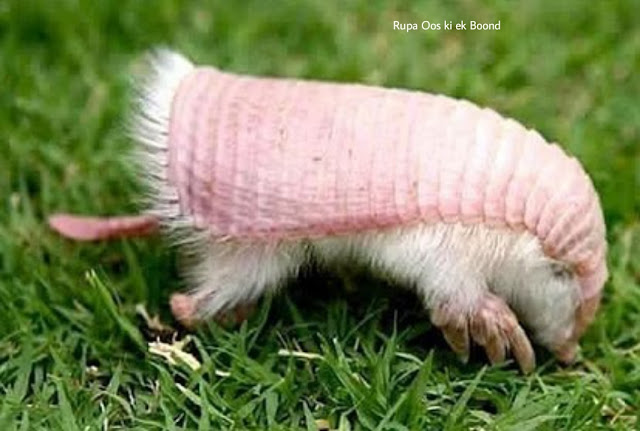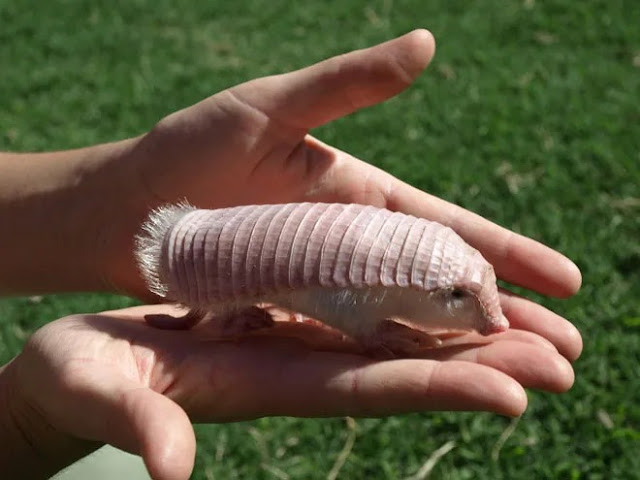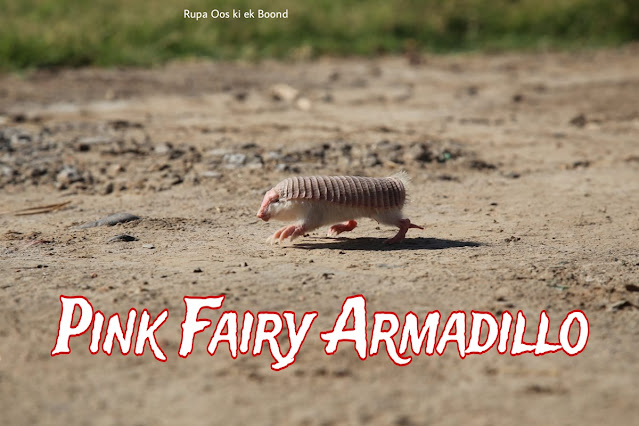पिंक फेयरी आर्माडिलो (Pink Fairy Armadillo)
पिंक फेयरी आर्माडिलो (Pink Fairy Armadillo) नाम का जीव देखने में किसी चूहे के जैसे लगता है। इसके शरीर के ऊपरी हिस्से को देखेंगे तो ऐसा लगेगा कि इसपर कोई परत अलग से लगाई गई है। ये जीव खुदाई करने में माहिर होता है। ये जमीन को इतनी तेजी से खोदता है कि ऐसा लगता है कि वह पानी में तैर रहा है।
गुलाबी परी आर्मडिलो 90-115 मिमी (3.5-4.5 इंच) लंबा होता है और आमतौर पर इसका वजन लगभग 120 ग्राम (4.2 औंस) होता है। यह प्रजाति सबसे छोटी जीवित आर्माडिलो है और सबसे कम ज्ञात प्रजातियों में से एक है। गुलाबी परी आर्मडिलो ( क्लैमीफोरस ट्रंकैटस ) आर्मडिलो की सबसे छोटी प्रजाति है ( क्लैमीफोरिडे और डेसीपोडिडे परिवारों के स्तनधारी एक बोनी कवच खोल द्वारा पहचाने जाते हैं)। वे मेंडोज़ा प्रांत के दक्षिण के साथ-साथ रियो नीग्रो के उत्तर और ब्यूनस आयर्स के दक्षिण में पाए गए हैं। इसका वर्णन सबसे पहले 1825 में रिचर्ड हार्लन ने किया था।
यह एकान्त में रहने वाला रेगिस्तान-अनुकूलित जानवर है। मध्य अर्जेंटीना के लिए स्थानिक और रेतीले मैदानों, टीलों और झाड़ीदार घास के मैदानों में पाया जाता है, जहां वसंत और गर्मियों की अवधि के दौरान विभिन्न प्रकार की पतली लैरीया और पोर्टुलाका झाड़ियाँ दिखाई देती हैं। यह रेतीले मैदानों और टीलों में भी रहता है। गुलाबी परी आर्मडिलोस की छोटी आंखें, रेशमी पीला सफेद फर और एक लचीला पृष्ठीय खोल होता है, जो केवल एक पतली पृष्ठीय झिल्ली द्वारा इसके शरीर से जुड़ा होता है । इसके अलावा इसकी स्पैटुला के आकार की पूंछ इसके खोल के कुंद पिछले हिस्से में एक ऊर्ध्वाधर प्लेट से निकलती है।
यह प्राणी रात्रिचर और एकान्तवासी होता है और इसका आहार मुख्य रूप से कीड़े, घोंघे और विभिन्न पौधों के हिस्सों से बना होता है। भूमिगत रहते हुए चींटियाँ और लार्वा इसके मुख्य भोजन स्रोत हैं। गुलाबी परी आर्माडिलो के संरक्षण की स्थिति अभी भी अनिश्चित है और इसे आईयूसीएन की संकटग्रस्त प्रजातियों की लाल सूची में डेटा की कमी के रूप में सूचीबद्ध किया गया है।
इस प्रजाति की जनसंख्या में गिरावट का कारण आम तौर पर कृषि गतिविधियों और घरेलू कुत्तों और बिल्लियों सहित शिकारियों को माना गया है। गुलाबी परी आर्माडिलोस कुछ दशकों पहले की तुलना में कम पाए जाते हैं और मैदानी दृश्य दुर्लभ और आकस्मिक रहे हैं।
2006 में, आर्मडिलो को IUCN रेड लिस्ट में निकट-खतरे की श्रेणी में रखा गया था । 2008 में इसकी जनसंख्या गतिशीलता और प्राकृतिक इतिहास पर वैज्ञानिक जानकारी की कमी के कारण इसे डेटा की कमी वाली श्रेणी में स्थानांतरित कर दिया गया था । इस बात की पुष्टि की गई है कि मैदानी दृश्य दुर्लभ और पहले की तुलना में कम आम हैं, भले ही गुलाबी परी आर्माडिलो को उसकी रात्रिकालीन जीवाश्म जीवन शैली के कारण देखना पहले से ही मुश्किल है।
English Translate
Pink Fairy Armadillo
The creature named Pink Fairy Ramadillo looks like someone else. If we look at the upper parts of its body, it is so useless that nothing is clearly visible on it. These creatures are adept at digging. This land has risen so fast that it seems as if it is floating in water.
The pink fairy armadillo measures 90–115 mm (3.5–4.5 in) long and typically weighs around 120 g (4.2 in). It is the smallest living armadillo and one of the smallest living creatures. The pink fairy armadillo (Chlamyphorus cruetates) is the smallest branch of the armadillos (mammals of the families Chlamyphoridae and Dasypodidae distinguished by a bony carapace shell). They were found in the south of Mendoza province as well as north of the Río Negro and south of Buenos Aires. It was first described by Richard Harlan in 1825.
It is a solitary desert-adapted animal. The locality is found in sandy plains, dunes and ornamental grasslands throughout central Argentina, where a variety of layers of lyreia and portulaca shrubs appear in the spring and summer season. It also lives in sandy plains and dunes. Pink fairy armadillos have small eyes, silky pale white coats, and a flexible dorsal coat, with only a single flaky dorsal coat attached to its body. Apart from its spatula-shaped tail, the rear part of its shell is drooping from a substrate in the furrow.
This creature is nocturnal and solitary and its diet consists mainly of insects, snails and various wasps. Whole-life ants and insects are its main food sources. The conservation status of the pink fairy armadillo is still of concern and it is listed as data deficient on the IUCN Red List of Threatened Animals.
The decline in this portfolio has generally been attributed to agricultural factories and domesticated hunters and hunters. Pink fairy armadillos are less common than they were a few decades ago and plains sightings remain rare and unique.
In 2006, the armadillo was classified as near-threatened on the IUCN Red List. Its data deficient category was changed in 2008 due to lack of scientific information. This has confirmed that plains sightings are rare and less common than previously thought, even though the pink fairy armadillo has previously been very difficult to see due to its nocturnal sculptural lifestyle.






🙏🙏
ReplyDeleteInteresting facts
ReplyDeleteVery Interesting Facts and information
ReplyDeleteबहुत ही खूबसूरत लेख रोचक जानकारी🙏🏻
ReplyDeleteVery Nice 👌🏻
ReplyDeleteVery Nice
ReplyDeleteअद्भुत जानकारी🙏
ReplyDeleteWonderful facts...
ReplyDeleteRare information
ReplyDeleteYe to kabhi suna hi nahi tha..
ReplyDeleteNICE information
ReplyDelete🙏🙏💐💐सुप्रभात 🕉️
ReplyDelete🙏ॐ नमः शिवाय 🚩🚩🚩
🙏जय शिव शम्भू 🚩🚩🚩
👌👌👌अद्धभुत व रोचक जानकारी शेयर करने के लिए आप का बहुत बहुत धन्यवाद 💐💐
दिलचस्प जानकारी
ReplyDeleteVery nice information 👌👍🙏🚩🙌🏽
ReplyDeleteVery interesting information
ReplyDeleteVery interesting information
ReplyDeletePretty pet.
ReplyDelete